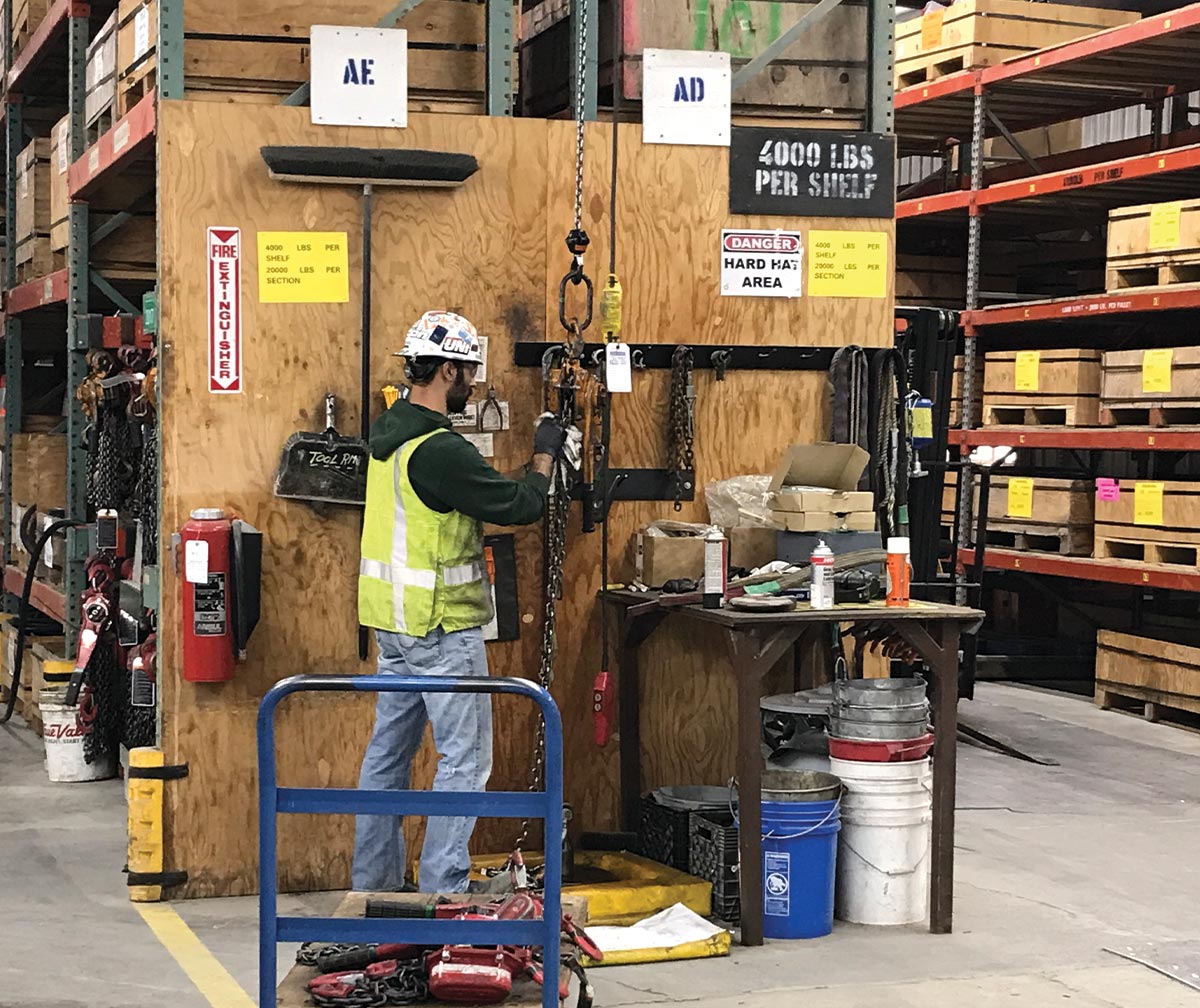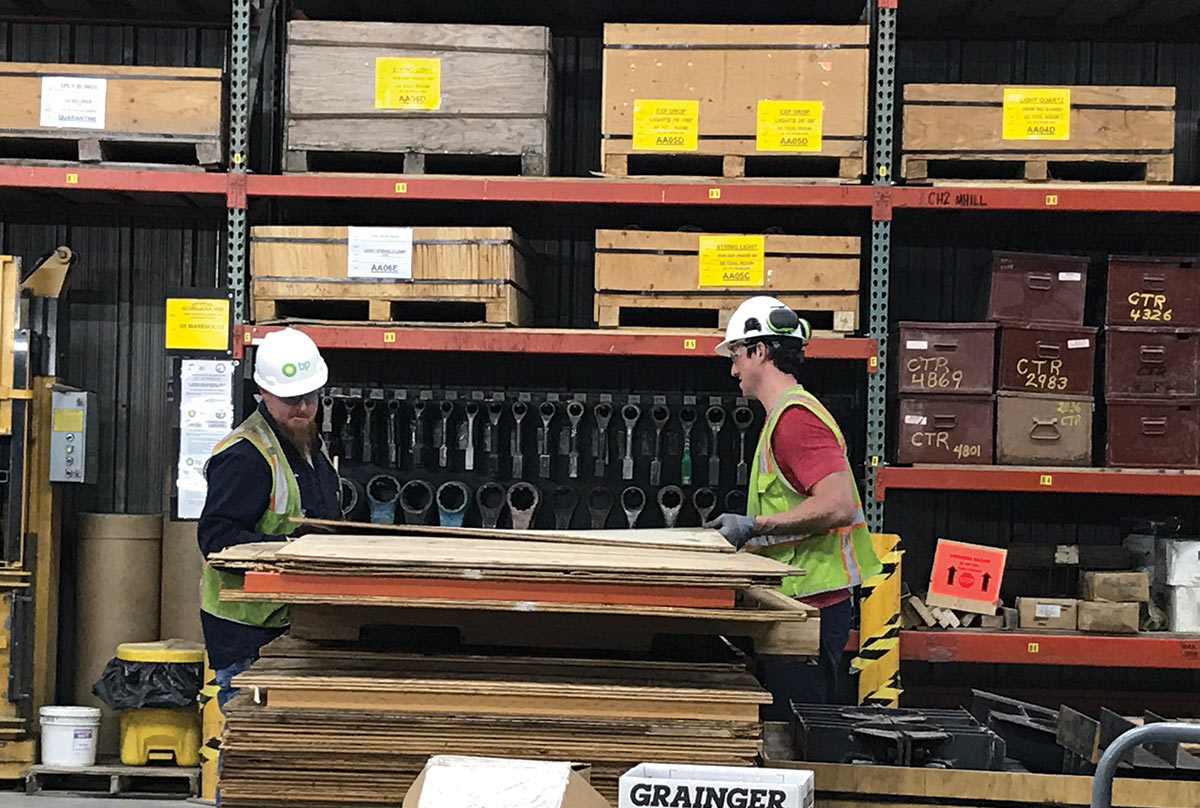Where Oh Where Have Warehouses Gone?
Creative uses of industrial storage space
arehouses are easy to ignore. Almost by definition, they are places that the general public passes by but rarely visits.
“Most of the time you don’t allow the public inside because of the safety requirements,” says Rosita Johnson, business development manager for Advanced Supply Chain International (ASCI) in Anchorage. The company manages inventory contained inside buildings stacked to the roof with pallets, forklifts scooting to and fro.
A warehouse is defined less by its form than by function. “It doesn’t have anything to do with what the building looks like; it is what the zoning allows you to do in that building,” explains Elisha Martin, a real estate broker with Colliers International. While many warehouses have large roll-up doors, some don’t. Most are designed around access for delivery trucks, and as a rule they are places where only people who work there ever see the inside.
Commercial property spans retail, office, and various industrial uses, of which warehousing is just one. A warehouse might contain a manufacturer or, as the name suggests, wares being stocked for retail distribution. They store materials and equipment.
“In the last year, we’ve worked with a company that does fittings and hoses, electrical parts, airplane parts, medical supplies, core samples,” Martin says. “It always goes back to what’s in the zoning and what’s allowed in those buildings and what’s not allowed in other areas.”
Lately, users have had to accept less than suitable spaces. A relative scarcity of warehouses in Alaska demands some clever solutions.
Maximizing bare minimum warehouse space has been ASCI’s specialty since 1999. The company provides full-service supply chain management support, overseeing more than $300 million worth of inventory annually. At any given time, the company tracks more than 100,000 individual SKUs (stock keeping units); Johnson says a typical warehouse holds about 14,000 SKUs.
End-to-end management allows for more flexibility, she says, by minimizing conflicts with multiple contractors. This efficiency enables ASCI to save clients money, which the company estimates at more than $606 million in reduced costs over the last five years.
One of the tricks, says Johnson, is consolidating inventory bound for the North Slope in Anchorage first. “Even though you’d think that’s an extra step, slow down the shipments—in the end, if you have an inaccurate or damaged item that gets to the North Slope, it’s a lot more expensive to handle it when it’s on the North Slope. If you catch this in Anchorage, it becomes a cost avoidance,” she explains.
ASCI also helps clients reduce the amount of inventory that must be warehoused in the first place. Johnson points to an analysis ASCI did for BP. “They had a lot of what we call ‘dead inventory.’ Some of them were critical spares—you have to be careful not to get rid of those—but some of those items were no longer functional, so when you optimize inventory levels, what happens is you free up warehouse space,” she explains. As a result, ASCI shrank BP’s storage footprint. Fewer facilities means lower overhead, with fewer personnel required to maintain them.
ASCI’s experience on the North Slope taught managers lessons that might not be obvious. “Certain items you can’t store outside,” Johnson says, and that includes ordinary office paper. The company learned that certain thicknesses of paper would become rigid if stored in conditions that are too cold and dry.
Adding more tools to its kit, last summer ASCI became the Alaska affiliate of American Chain of Warehouses, Inc., a national nonprofit that matches companies with logistics and warehouse providers. With membership comes access to the latest warehouse management technologies and market research.
The information exchange goes both ways, according to Johnson. “So far, a lot of companies from the Lower 48 have been reaching out to us,” she says, “because if you function in Alaska… it shows we can pretty much run warehouse operations anywhere.”
One obstacle that warehouse operations are dealing with in Alaska is a shortage of warehouse space.
“Warehouse is the tightest commercial property we have in Alaska,” says Martin. “There’s approximately 12 to 13 million square feet of [industrial] property in Anchorage, and we are at a vacancy of between 2 and 3 percent. That is below the national average for property availability.” According to Colliers, the average rate nationwide is 3.7 percent vacant.
“So far, a lot of companies from the Lower 48 have been reaching out to us because if you function in Alaska… it shows we can pretty much run warehouse operations anywhere.”
Business Development Manager
Advanced Supply Chain International
Other types of commercial space are plentiful, especially in Anchorage. “If you wanted to tour 20,000 square feet of office space, I could give you eight opportunities, if not more, and that would be after narrowing it down, probably,” Martin says. “I think there’s 200-plus listings for office space right now just in this Midtown area.”
Smaller warehouses are in particularly short supply. “If you’re looking for a warehouse that’s maybe 2,000 square feet or 4,000 square feet, they’re very hard to come by because larger users have taken those spaces and combined them,” Martin says. “The client that needs, like, 1,500 square feet, I have to simply call around to other brokers in town that I know have properties in that range and see if anybody is coming up [for sale soon] or not paying the rent.”
The reason for the warehouse shortage, in Anchorage at least, is the same that limits residential growth: not enough land. Wedged between the ocean and the mountains and with military reserve occupying much of the Municipality, the remaining industrial land in the Anchorage Bowl is difficult to develop. “If it is developable, it is expensive,” Martin explains. “You’d be talking about probably $14 to $18 per square foot to be able to purchase the land.” Add to that the extraordinarily high cost of construction. Consequently, not much new warehouse space has been built. Martin estimates about 1 million square feet in the last five years, which is not a lot for a market Anchorage’s size.
And warehouses want to be in Anchorage. “It is very much location based,” Martin says. “The proximity to the airport and to the port are usually logistically things that are very important to clients when they’re either moving in the market or moving within the market.”
Another reason for the shortage of space is the recent supply chain disruptions. Before a couple years ago, manufacturers streamlined operations to minimize the amount of goods sitting in warehouses. “We’ve always had this balance between just-in-time and keeping product on hand,” says Alyssa Rodrigues, director of Alaska Manufacturing Extension Partnership (Alaska MEP), a program of the National Institute of Standards and Technology hosted by UAA.
ASCI specializes in inventory management on the North Slope for oil and gas companies and their support contractors.
ASCI
ASCI specializes in inventory management on the North Slope for oil and gas companies and their support contractors.
ASCI

Supply chain disruptions tilted the calculation in favor of having more wares stocked up, filling every inch of available storage space.
A feedback loop adds to the problem. Scarcity raises rent prices, which in turn discourages new construction. “The rent would need to be between $19 to $21 per square foot annually,” Martin explains. “This won’t pencil out for most businesses. The business will likely take a less desirable warehouse to fit the financial business model.”
Lack of warehouse space constrains business opportunities. Rodrigues gives the example of a manufacturer that gets a huge order but doesn’t have enough material on hand. “If I don’t have my inputs, then I can’t either make that sale or deliver that sale—which in many cases is worse than not taking the sale to begin with,” she says. Rodrigues adds that she’s seen this problem arise many times.
By optimizing the amount of inventory for clients, ASCI can reduce the number of workers needed to manage it, lowering overhead costs.
ASCI
ASCI

Creative Solutions
Apart from waiting for an economic boom to change the bottom-line calculation, warehouse users do have options to escape the scarcity trap.
Pooling resources, for starters. Johnson saw an example in October at Alaska MEP’s Kenai Peninsula Manufacturing Roadshow. “There were two manufacturers sitting next to each other. One makes tea and another one sells cheeses and some other Alaska-made goods,” she recalls. “They have to share warehouse space, and they have to figure out who is responsible for certain safety regulations or requirements.”
Alaska MEP is working with companies to find opportunities for consolidation. “Say there’s three that need to buy organic oats,” Rodrigues says. “They can place those orders together, have them shipped and warehoused all together, and hopefully save some money.”
Or, instead of compatible roommates, warehouse users can break up their space. Johnson points to a local maker of dehydrated foods. “They have three small storage facilities within the same small area,” she says. “Eventually they do want to have a bigger building, but it’s just not as easy.”
Another strategy is converting buildings that were originally used for something else. Martin suggests the now-vacant Northway Mall in Anchorage. “Malls are less and less attractive for retail clients, and there’s been a lot of conversion of malls into other uses,” she says. Clients who’ve been looking for space for a long time might resort to conversion of sub-optimal buildings. “Ceiling height, loading dock doors, and things like that—but those obstacles can be overcome,” Martin says.
In Anchorage, the former Toys “R” Us store is now a distribution center for the Costco next door. Not far away, up Dimond Boulevard, the former Sam’s Club store is now an outlet for Alaska Industrial Hardware, which uses the vast floor space for additional storage.
The Matanuska-Susitna Borough, having more buildable land, is an alternative for businesses not tied to Anchorage’s logistics hubs. The Mat-Su Borough has its own logistics hub at Port Mackenzie, too, yet Martin doesn’t see that area as a complete replacement. “That doesn’t put them in proximity to distribute to the rest of Alaska. Some of the tenants that are here are distributing to local vendors that are in Anchorage also, and that would be their major area. If they are distributing throughout all of Alaska, they may have a location here in Anchorage and one in Fairbanks, but not likely they would have one in the Mat-Su,” she says.
In her view, the most practical solution is the creative use of existing space. Martin points to one client looking for 14,000 square feet that settled, after a year and a half, on a building that requires a $300,000 sprinkler system upgrade. “It really becomes more scouring the market for an underused building. Usually the opportunity comes in somebody’s change in their need: somebody needs to upsize or downsize, which leaves a hole in the market that can be backfilled by someone else,” Martin says.
Under CEO and co-owner Christine Hopkins, ASCI is now the Alaska affiliate of American Chain of Warehouses, Inc., a nonprofit service-matching organization.
ASCI

ASCI
Moving In
Everything points to the warehouse shortage easing up, according to Johnson. She cites an improvement in space utilization since 2021.
Some disused space is also returning to life. The former JC Penney warehouse on Arctic Boulevard in Midtown Anchorage sold to an out-of-state buyer in the last year, but Martin isn’t sure what the plans for the building are. Before it opens, there’s a lot of deferred maintenance. “Those are the types of obstacles we see in a warehouse that’s existing: great bones, great structure, but a lot of other factors,” she says.
In 2022, ASCI was awarded its first federal contract, worth $12.4 million for one year, to provide logistics service support for both military and civilian agencies in Alaska.
ASCI
ASCI

“If you’re looking for a warehouse that’s maybe 2,000 square feet or 4,000 square feet, they’re very hard to come by because larger users have taken those spaces and combined them.”
She did find a new tenant for the former Sears warehouse at Old Seward Highway and Dowling Road. Time Equities, Inc. bought the building in April 2022 (along with the Midtown Mall which formerly hosted Anchorage’s Sears store), which has been empty since Sears downsized in 2018. Rather than divide its 88,000 square feet for multiple smaller tenants, “the owner felt like there was going to be an opportunity for a single user, and we have that now,” Martin says. That single user was announced in December: Amazon is turning the warehouse into a sorting facility.
Martin expects Amazon will add to the roughly 4,500 warehouse workers in Anchorage. After sitting empty for five years, putting those 88,000 square feet back to productive use lifts the entire economy.
More broadly, the demand for warehouses by manufacturers and merchants is a sign of growth. “As we see them expand in our market, that’s positive,” Martin says. “To see them needing more space for those products because they’re looking at projects that are coming down the pipeline in the state… Those things are exciting.”![]()